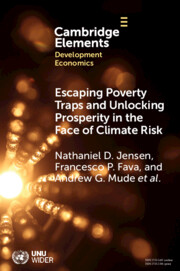1132 results

Escaping Poverty Traps and Unlocking Prosperity in the Face of Climate Risk
- Lessons from Index-Based Livestock Insurance
- Coming soon
-
- Expected online publication date:
- June 2024
- Print publication:
- 30 June 2024
-
- Element
- Export citation
19 - Community Arts, Decoloniality, and Epistemic Justice
- from Part V - Participatory and Community Arts
-
-
- Book:
- The Cambridge Handbook of Community Empowerment
- Published online:
- 18 April 2024
- Print publication:
- 25 April 2024, pp 480-504
-
- Chapter
- Export citation
Influence of Silicon and Phosphorus on Structural and Magnetic Properties of Synthetic Goethite and Related Oxides
-
- Journal:
- Clays and Clay Minerals / Volume 36 / Issue 2 / April 1988
- Published online by Cambridge University Press:
- 02 April 2024, pp. 165-175
-
- Article
- Export citation
Bleeding Control Protections Within US Good Samaritan Laws
-
- Journal:
- Prehospital and Disaster Medicine / Volume 39 / Issue 2 / April 2024
- Published online by Cambridge University Press:
- 04 April 2024, pp. 156-162
- Print publication:
- April 2024
-
- Article
- Export citation
List of abbreviations
-
- Book:
- Slavery and Dependence in Ancient Egypt
- Published online:
- 01 March 2024
- Print publication:
- 21 March 2024, pp xxii-xxiii
-
- Chapter
- Export citation
Concordance of texts
-
- Book:
- Slavery and Dependence in Ancient Egypt
- Published online:
- 01 March 2024
- Print publication:
- 21 March 2024, pp 432-435
-
- Chapter
- Export citation
Biographical notice on Jane Rowlandson
-
- Book:
- Slavery and Dependence in Ancient Egypt
- Published online:
- 01 March 2024
- Print publication:
- 21 March 2024, pp xvii-xviii
-
- Chapter
- Export citation
Glossary of technical terms
-
- Book:
- Slavery and Dependence in Ancient Egypt
- Published online:
- 01 March 2024
- Print publication:
- 21 March 2024, pp xxxii-l
-
- Chapter
- Export citation
Bibliography
-
- Book:
- Slavery and Dependence in Ancient Egypt
- Published online:
- 01 March 2024
- Print publication:
- 21 March 2024, pp 436-475
-
- Chapter
- Export citation
4 - Jewish perspectives on slavery in Egypt
-
- Book:
- Slavery and Dependence in Ancient Egypt
- Published online:
- 01 March 2024
- Print publication:
- 21 March 2024, pp 176-210
-
- Chapter
- Export citation
Contents
-
- Book:
- Slavery and Dependence in Ancient Egypt
- Published online:
- 01 March 2024
- Print publication:
- 21 March 2024, pp v-ix
-
- Chapter
- Export citation
List of contributors
-
- Book:
- Slavery and Dependence in Ancient Egypt
- Published online:
- 01 March 2024
- Print publication:
- 21 March 2024, pp xiv-xvi
-
- Chapter
- Export citation
Frontmatter
-
- Book:
- Slavery and Dependence in Ancient Egypt
- Published online:
- 01 March 2024
- Print publication:
- 21 March 2024, pp i-iv
-
- Chapter
- Export citation
Preface
-
- Book:
- Slavery and Dependence in Ancient Egypt
- Published online:
- 01 March 2024
- Print publication:
- 21 March 2024, pp xix-xxi
-
- Chapter
- Export citation
2 - Pharaonic Egypt
-
- Book:
- Slavery and Dependence in Ancient Egypt
- Published online:
- 01 March 2024
- Print publication:
- 21 March 2024, pp 37-118
-
- Chapter
-
- You have access
- Export citation
List of illustrations
-
- Book:
- Slavery and Dependence in Ancient Egypt
- Published online:
- 01 March 2024
- Print publication:
- 21 March 2024, pp x-xii
-
- Chapter
- Export citation
1 - Introduction
-
- Book:
- Slavery and Dependence in Ancient Egypt
- Published online:
- 01 March 2024
- Print publication:
- 21 March 2024, pp 1-36
-
- Chapter
- Export citation
Index
-
- Book:
- Slavery and Dependence in Ancient Egypt
- Published online:
- 01 March 2024
- Print publication:
- 21 March 2024, pp 476-486
-
- Chapter
- Export citation
7 - Byzantine and Umayyad Egypt
-
- Book:
- Slavery and Dependence in Ancient Egypt
- Published online:
- 01 March 2024
- Print publication:
- 21 March 2024, pp 343-431
-
- Chapter
- Export citation
6 - Roman Egypt
-
- Book:
- Slavery and Dependence in Ancient Egypt
- Published online:
- 01 March 2024
- Print publication:
- 21 March 2024, pp 274-342
-
- Chapter
- Export citation



